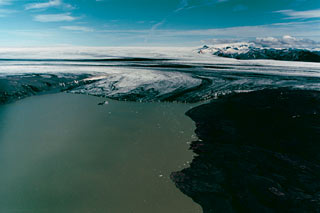|
 |
 |




|

The glacier series, 1999 (detail). C-prints mounted on board, 12 5/8 x 18 7/8 inches. Edition 4/6. Solomon R. Guggenheim Museum, New York, Purchased with funds contributed by the Photography Committee. 2000.69 |
 |
 |
Olafur Eliasson re-creates and intervenes upon natural phenomena as a way of investigating perception. Employing straightforward means such as garden hoses, mirrors, water, and direct sunlight, he has constructed a waterfall in a museum courtyard, a small rain storm contained within a gallery space, and one work that consisted simply of clouds of steam rising from a pool of water. The natural environment is also the subject of his photographic works. (Eliasson does not exhibit his photographs with his installations, making clear his particular distinction between "reality" and "representation.") His serial, documentary images of glaciers, rivers, islands, and caves (located mostly in Iceland) function as "sketches" for his installations and their attendant investigation of what he has called "the discrepancy between the experience of seeing and the knowledge or expectation of what we are seeing." This exploration of where, when, and how close we can get to seeing and experiencing nature is exemplified by the many aerial views in The glacier series (1999). This grid of photographs reveals a vantage point that can only be seen via technological intervention, by airplane or helicopter. Its imagery of rapidly melting glacial ice records an environmental crisis that is caused by unchecked technological development.
|
|















